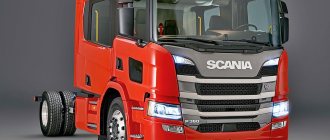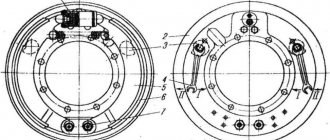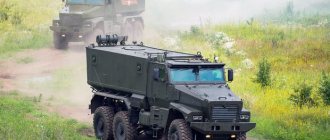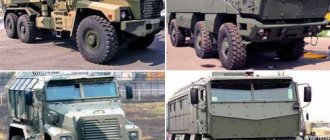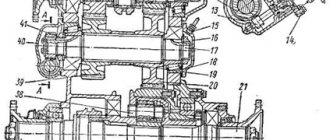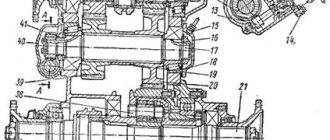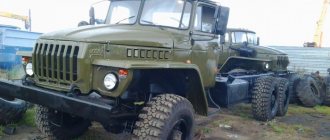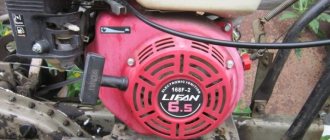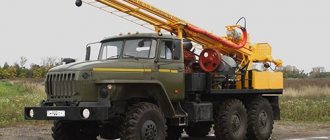Comfort and combat power
Typhoon-VDV (the original name of the model. Now usually called Typhoon-D) was presented to the public in October 2022 at the Interpolitech exhibition. The car does not give the impression of a large and oversized car, although it is many times larger than any SUV and weighs 13 tons. This was the first time I saw this model with the fire turret already installed. It looks brutal: without a 30-mm cannon, it was just a machine.
"Athlete" for infantry
In 2022, state tests of a new line of weapons of the Ground Forces will be completed: armored vehicles of the Atlet family. While providing high levels of mobility, these vehicles have increased security and load-carrying capacity. “Athletes” have a 4x4 wheel arrangement and are designed for transporting personnel and military cargo while providing the required level of protection, towing trailers, mounting weapons, military and special equipment.
The Atlet's load capacity is 1,600 kg, the maximum power of the YaMZ-5347-24 diesel engine is 240 hp. As standard, armored vehicles are equipped with anti-traumatic seats for all crew members and air conditioning.
No experience required
I especially liked the car for its solidity and ability to drive on difficult roads. Unfortunately, it is not yet known what endurance margin Typhoon-D has. And it is unclear how easy it will be to repair the Typhoon in combat conditions.
Testers say that they are “tormenting” the car around the clock: the model is still undergoing running and combat tests. Now designers are literally trying to break the car and find out the maximum load threshold so that all weak points become obvious and are eliminated at the testing stage.
Military engineers have a saying: as soon as the TV crews turn on the cameras, something goes wrong. The technique in this regard is capricious and shows character. We are used to this, we even sometimes reassure developers if something doesn’t work. There were no such problems with Typhoon. He never hesitated.
To control a combat vehicle, driving skills, oddly enough, require standard ones. I, being an ordinary driver, got behind the wheel and immediately drove off. Moreover, the armored car is quite friendly in this regard - there is even a rear view camera that helps when parking. Probably only a driving school student could encounter difficulties here. The only difficulty: if you want to dig around under the hood, it will be problematic to do so: on top of the hood there is an armored plate that cannot be lifted by one person.
There are no world analogues of such a car yet. The Typhoon's ability to land from the air is a very complex technology in itself. The car is ready to land in extreme conditions of any season, and after landing it immediately starts and drives. In addition, this vehicle has full-fledged artillery weapons on board, which greatly increases its effectiveness as a combat unit. The purpose of such equipment is to be ahead at the line of fire. Typhoon-D is an assault vehicle, and hiding is not in its nature.
Typhoon-VDV (Typhoon-D)Weight 13.5 t |
Armored car for drifting - test drive of a landing vehicle
Typhoon vs Typhoon
What is common in the design of the Kama Typhoon-K and the Ural Typhoon-U is an independent and adjustable suspension on all wheels, an automatic transmission, an on-board information and control system (BIUS), combat-resistant wheels that allow movement if damaged, and very powerful armor protection.
The first samples of Tyfunov-U, built in 2011: modular Ural-63095 (front) and single-volume Ural-63099. Round headlights with LEDs and octagonal “nut” housings are clearly visible
In the first samples, it was made completely “heavy-duty”, from a heavy machine gun (the thickness of the armored glass is 130 mm!). Kamaz even dreamed of protecting the “forehead” of one of their models from a 30-mm cannon. But such a “shell” is very heavy, and also requires the use of expensive ceramics.
Two-axle Ural-53099: according to our information, it was made from a three-axle Ural-63099 (Photo by Sergei ORLOV)
Therefore, according to our information, the current Typhoons received armor that is more traditional for armored vehicles and less weighty - according to the highest class of GOST "6a", from armor-piercing incendiary bullets of the Dragunov sniper rifle, not to mention the Kalashnikov assault rifle. By the way, armored personnel carriers have similar side protection (their “forehead” is more powerfully armored).
But, unlike armored personnel carriers, which are not designed for explosions, Typhoons must withstand the explosion of a mine or land mine weighing up to 8 kg: armored modules have a V-shaped bottom that dissipates the effect of the shock wave, the body and cabin are raised high above the ground, the seats are suspended from the walls and ceiling .
Serial production of Typhoons-U in the workshop of the automobile plant (facebook.com/dmitry.rogozin)
The armored hulls, cabins and tail of the Typhoon-U are welded at the Moscow Research Institute of Steel (Photo of the Research Institute of Steel)
0 / 0
And the main difference between the armored cars of KAMAZ and the Urals is also partly related to explosion protection. The fact is that each of the plants remained faithful to its traditional layout: Typhoons-K are cabover, and Typhoons-U are “nosed”. Surely the KAMAZ team has its own arguments, but if a mine explodes under the front wheel of a bonneted vehicle, the impact will fall on the engine, and in a cabover one - on the cabin... In addition, hooded trucks are easier to maintain the engine and are easier to make “single-volume”, combining the interior with cabin.
Kamazov Typhoon-K at the parade on May 9 in Moscow. Seeing the cars, the children asked: “Where do these armored personnel carriers have a gun?” and “Why are they driving backwards?” The point is the unusual arrangement of the bridges: due to the heavy front part, two bridges are located in front, and not behind, as usual (Photo by Konstantin ZAKURDAEV)
There is another important difference between the Typhoons of both brands - we would say strategic. Kamaz uses the American Allison automatic transmission, German armored ceramics, and French combat-resistant wheels with inserts. All this, firstly, increases the already considerable price of the car. And secondly, is the use of components from “potential enemy” countries justified, especially in the current conditions? The same Rogozin recently called on the Russian defense industry to abandon import purchases!
KAMAZ
Currently, the Kama auto giant produces two groups of military vehicles for the Moscow Region. The first group includes vehicles (KAMAZ-43114 family), which should soon leave the assembly line. The second includes multi-purpose vehicles of the Mustang family. This family has been mastered in production, and the technical level of the Mustangs allows for consistent modernization of the family vehicles over the next 10 years in order to best meet the needs of the Moscow Region. On its own initiative, KAMAZ OJSC continues to constantly expand this family. In particular, this applies to the creation of cars with open and hidden cabin armor. Among the latest developments of Chelny residents, several new cars can be noted. Among them is a special four-axle artillery tractor based on the KamAZ-6350 for towing guns. The cabin, crew compartment, bottom of the power unit, gas tanks and battery compartment with hidden armor are in protection class V. The equipment includes a manipulator for loading and unloading ammunition and an on-board platform. To replace the discontinued GAZ-66 vehicles in the airborne troops, the KamAZ-43501 airborne vehicle has been prepared. The KamAZ-53501 is designed for transportation of components of the pontoon fleet, which is capable of replacing Ukrainian-made KrAZ vehicles previously used in the pontoon fleet.
KAMAZ OJSC places great hopes on the joint project with MSTU named after. Bauman developed the KamAZ-43269 “Vystrel” armored car. It is designed to accompany convoys, patrol in zones of armed conflicts, transport personnel, or even for mounting certain types of weapons. The main advantage of the Vystrel over the armored personnel carrier is its lower cost and much longer service life of the units. Currently, “Vystrel” is undergoing state tests, based on the results of which a decision will be made on the possibility of using this type of armored vehicle in the Armed Forces. In the future, Kama automakers plan to expand the Vystrel family by creating three and four-axle armored vehicles of this type, as well as create a completely new, unified family of military multi-purpose vehicles with a carrying capacity of 4 to 15 tons.
Modifications of the KamAZ-43269 “Vystrel” armored car (BPM-97)
- BPM-97
is a variant of KamAZ-43269 “Shot” for ground forces. - KamAZ-43269 “Dozor”
- modification for border troops. - KamAZ-43269 "Vystrel" (modernized)
- a modernized version of the original armored vehicle, with a modified windshield, windshield wipers, a relocated air intake and an installed air purification system. - KamAZ-43269 with MB2 BPPU
- a modification equipped with a 30-mm cannon. - KamAZ-43269 with the Strela-10M air defense system
- a modification equipped with the Strela-10M anti-aircraft missile system.
Option KamAZ-43269 with the Strela-10M anti-aircraft missile system
Historical realism
They first started talking about protected Typhoon vehicles in the summer of 2011, when a semi-closed demonstration of this equipment took place to the then Minister of Defense of the Russian Federation Anatoly Serdyukov. In particular, prototypes of KAMAZ-63968, Ural-63099 and Ural-63095 were shown. The equipment was shown only briefly on TV, and the upcoming scope of modernization of the military equipment fleet could only be understood from specialized federal media (see “GP” No. 8, 2011).
The published data read: KAMAZ OJSC and Ural Automobile Plant are creating families of protected vehicles with 4x4, 6x6, 8x8 wheel arrangements. The background to their appearance is thorny and ornate.
Since the beginning of the 2000s, the topic of the global division of labor and Russia’s participation in it has been actively promoted. There was a reason for this, as HSE scientific director Evgeniy Yasin confirmed: “We cannot produce competitive products in all sectors of the economy. Something will have to be purchased externally.”
To this must be added the high costs of producing one unit of output. Since the 1960s, labor productivity in the mechanical engineering industry of the USSR, the Russian Federation and a number of CIS countries has rarely risen above 40% compared to the American or German levels.
That is why in 2008 a course was chosen to purchase military products abroad, including military vehicles and automotive components for them.
The automotive industry, in which the most important component is the production of auto components, was supposed to be transferred to import assembly. But the correctness of the chosen course was not obvious: after all, more than 95% of the ground mobile weapons and military equipment of the Russian Armed Forces are mounted on automobile base chassis.
The understanding that in the event of any friction with the EU, NATO and other blocs and alliances a systemic crisis is possible came later, when global politics began to interfere with Russia’s export interests: wars and coups d’etat in Libya, Egypt, Iran, Syria led to the loss of economic contracts and loss of profitable deals.
Design of the armored vehicle KamAZ-43269 “Vystrel” (BPM-97)
The KamAZ-43269 “Vystrel” armored vehicle has a welded supporting body produced by Kurganmashzavod. The upper part of the hull can withstand shots from a large-caliber 12.7-mm NSV machine gun from a distance of 300 m, the lower part and rear - from a 7.62-mm SVD sniper rifle from a distance of 30 m. The bottom of the vehicle is also armored.
Armored vehicle KamAZ-43269 “Vystrel” (BMP-97), original version. This is what the car looked like before modernization
Inside, the body of the Vystrel is divided into an engine compartment and a combined compartment for the crew and troops. The hull has side and rear aft doors, hatches for troops and hatches for the mechanic and older vehicle.
The fuel tanks of the BPM-97 (2 x 125 l) are protected; another, additional fuel tank with a capacity of 20 l is located in an armored housing. The vehicle is equipped with an autonomous heater that allows you to maintain operating temperature in the compartment for the crew and troops, regardless of engine operation. A filter and ventilation unit is also installed on the car.
The use of components and assemblies unified with civilian trucks makes it possible to provide the KamAZ-43269 “Vystrel” with a range of 270 thousand kilometers before major repairs. Serial components and assemblies make it possible to simplify the processes of production and repair of a car, and significantly reduce the cost of production. An important advantage of this approach is the ability to carry out technical inspection and repair of an armored car using means intended for conventional production vehicles and chassis produced by KamAZ OJSC.
And this is the already modernized KamAZ-43269 “Vystrel” (BMP-97). Among the external differences: the windshield became solid, a filter and ventilation device appeared at the back of the body
Northern vector
Growing tensions in the Arctic - the last unspent "storehouse" of humankind's natural resources - required Russia to increase the activity of its Armed Forces in the circumpolar zone. Russian scientists and designers quickly responded to the pressing demand for the need to create vehicles prepared for trouble-free operation in Arctic conditions by developing a number of multifunctional all-terrain vehicles of various classes, capable of overcoming not only difficult sections of the Arctic terrain, but also crossing water obstacles.
© mil.ru
The latest two-link tracked amphibious all-terrain vehicles GAZ-3344-20 “Aleut” have recently entered service.
One of the combined arms formations of the Eastern Military District (VVO) recently received the latest two-link tracked amphibious all-terrain vehicles GAZ-3344-20 “Aleut”. The all-terrain vehicle is made according to a modular design. The front link is an energy module, which can also carry five military personnel. The rear link is a transformable passenger module with a capacity of 15 people. It can be converted into a medical unit or command post.
In the summer of 2022, testing of a prototype of the KamAZ-6355 Arktika heavy all-terrain vehicle began on the Yamal Peninsula. A vehicle with an 8x8 wheel arrangement is capable of transporting up to 16 tons of cargo across polar off-road conditions. KamAZ designers developed the vehicle in collaboration with scientists from Moscow State Technical University named after N.E. Bauman and Moscow Polytechnic University. Many technical solutions have been introduced into the project, which should make it a unique vehicle capable of efficient operation in the Arctic. The power of a new generation diesel engine with a single-stage turbocharging system is 450 hp, which allows the large-sized (truck weight - 40 tons, length - 12 m, width - 3.38 m, height - 3.9 m) "Arctic" to develop with load speed 50 km/h.
In Russia, work is actively continuing to create other vehicles for the domestic Arctic troops: snowmobiles, vehicles with ultra-low pressure tires, two-link tracked tractors.
History of origin
The idea of creating a unified automobile chassis arose in the USSR by the beginning of the 80s. To implement the project, the Garage program was launched, which was closed due to the collapse of the country and the cessation of funding.
The idea was returned only in 2010, when families of armored vehicles with a high degree of unification began to appear again within the framework of the concept of development of the armed forces.
The first prototypes of the vehicles began to be tested in the early summer of 2011 at the Bronnitsy training ground.
The largest factories in the Russian Federation for the production of civilian and military trucks, as well as a number of universities (creating the geometry of the armored hull and developing a hydromechanical transmission) took part in the creation of armored vehicles.
Deliveries of armored vehicles to the troops began at the end of 2014, when the first pilot batch of 30 vehicles was delivered.
Tactical and technical characteristics of the Typhoon armored vehicle in comparison with analogues
| Oshkosh M-ATV | Cougar | KamAZ-53949 | |
| A country | USA | Russia | |
| Length, mm | 6270 | 5910 | 5910 |
| Width, mm | 2490 | 2740 | 2448 |
| Height, mm | 2700 | 2640 | 3318 |
| Ground clearance, mm | — | 410 | 433 |
| engine's type | Turbocharged diesel | ||
| Power, hp | 370 | 330 | 350 |
| Highway speed, km/h | 105 | 105 | 105 |
| Cruising range on the highway, km | 515 | 515 | 850 |
New modification
The KAMAZ-53949 vehicle presented at Interpolitech 2014 was impressive. But he skipped the Army-2015 forum for a good reason: at that time he was being converted into a reconnaissance vehicle for display at the MAKS-2015 air show.
By this time, KAMAZ had distanced itself from the production of the Special Vehicles Plant, which became part of Remdizel OJSC. The Tula OJSC NPO Strela became interested in the machine. Previously, it produced a similar service-combat reconnaissance vehicle SBRM on the Tiger chassis (see GP, No. 9, 2012). But with the YaMZ engine it turned out to be cramped and heavier.
The purpose of the new reconnaissance vehicle, in which the number of seats has been reduced to 4 crew members, includes search, detection and identification of ground, surface stationary and moving targets in the daytime and at night, as well as solving problems of suppressing detected targets. This list also includes crew protection. The equipment includes a lifting-mast device with an optical-electronic system and radar, remotely controlled weapons with a 12.7 mm machine gun, a drone with a replaceable optical load, and a hexacopter with a replaceable optical or radar load.
The characteristics of the installed equipment make it possible to detect a human figure at a distance of 6 km, and a tank – 15 km. In automatic mode, the target-tank system recognizes at a distance of 4–6 km.
The hexocopter, which takes up half the space in the body, can hover above the ground for an hour at an altitude of up to 500 m in autonomous mode. When powered by a cable, the aircraft rises 50 m, since it also has to pull the wire from the ground.
In addition, CJSC Scientific and Technical Center Elins, CJSC Central Research Institute Burevestnik, CJSC TPK Linkos and CJSC NPO NELK participated in the development of a new type of reconnaissance vehicle. What will happen to this car and the Typhoon-K in particular has not yet been determined, but among the first tasks, of course, the car needs a domestic engine and transmission group.
